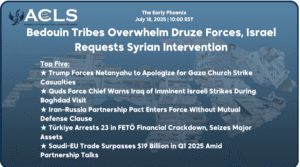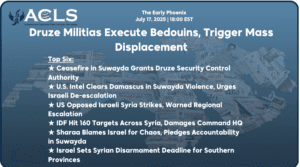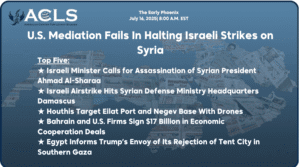By: Rania Kisar
Iran is striving to assert its influence in the Middle East, especially against the United States and Israel, without engaging in direct conflict. These efforts are showing a lack of effectiveness in Yemen, Syria, and Lebanon, where Iran faces increasing strategic challenges and pressures, the effects of which are becoming rapidly apparent. Conversely, the situation in Iraq is different; Iran is making notable progress, benefiting from the United States’ military restraint and diplomatic approach. The general trend indicates a decline in Iranian effectiveness in fronts requiring strong resolve and determination, while continuing to strengthen its position in Iraq, which remains under the influence of American policies.
★ Yemen Front
Despite direct involvement by IRGC and Lebanese Hezbollah leaders in Yemen, providing intelligence and coordinating Yemeni Houthi attacks against Israel-bound ships, their efforts have not yielded significant success. In a display of restrained power, targeted British and American airstrikes on Houthi facilities led to the deaths of 75 individuals, among them members of the Iranian Revolutionary Guard and Lebanese Hezbollah. The airstrikes also resulted in the destruction of missile platforms and drone depots, effectively thwarting planned Houthi operations that posed a threat to international shipping.
★ Syria Front
Iran faced its greatest setback this week in Syria after precise Israeli strikes took the lives of five top IRGC leaders. The IRGC confirmed the loss of significant members of the Quds Force’s elite, including the prominent intelligence figure, Hajj Sadak, who is known as the key architect behind operations countering American presence and orchestrating Iran’s logistical and security strategies in Syria. This ranks him higher than Sayyed Razi Mousavi, who was killed in a previous strike in December. Bashar Assad finds himself in an increasingly precarious position, facing threats from both Iran and Israel. Accusations from Iranian officials suggest espionage within the Assad regime, implying a betrayal that Iran is unlikely to overlook. Concurrently, the Israeli military demonstrates a resolute commitment to eradicating Iranian influence in Syria. This dual pressure places Assad in a critical situation, where his personal safety and political standing are jeopardized by the escalating tensions and suspicions from both neighboring powers. To understand more about the crosshairs Assad is caught in, watch this one minute video: Iranian Influence in Syria Under Siege: High-Level IRGC Figures Eliminated, Threaten Assad’s Regime.
★ Lebanon Front
The recent escalations between Hezbollah and Israel, which extend beyond mere skirmishes, highlight a significant asymmetry in the conflict. This was particularly evident in the Israeli drone strike that occurred this weekend in the Bint Jbeil district. The strike targeted the lead car of a convoy, believed to be transporting a senior Hezbollah commander according to a report by The Jerusalem Post. This action underscores Israel’s formidable intelligence capabilities and strategic boldness in targeting key Hezbollah figures.
The ineffectiveness of Hezbollah’s response, a purported strike on the Galilee region on Monday morning which Israeli media later confirmed hit an uninhabited area, is starkly juxtaposed against Israel’s decisive countermeasures. Following the elimination of a top Hezbollah officer, Sunday night saw the Israeli Air Force and IDF tanks executing two comprehensive waves of strikes, dismantling a military compound, outposts, and launch sites across southern Lebanon.
In conclusion, these events decisively affirm Israel’s superiority in intelligence and military power, enabling it to freely target crucial elements within Hezbollah. Israel’s strategic and robust military operations overshadow Hezbollah’s symbolic responses of retaliation, highlighting Hezbollah’s operational limitations and strategic inadequacies in the face of the immense and sophisticated might of the Israeli military. Compared to it, Hezbollah, as an unrecognized faction, is considered a significant obstacle to the security and development of its own country.
★ Iraq Front
Following Iran’s use of “Khaibar Shekan” missiles and drones in Erbil on January 16th, Iraqi officials quickly responded, focusing on refuting Iran’s claims about the presence of Israeli Mossad spy centers in the targeted area. This defensive response, rather than a clear condemnation of the attack, indicates a concerning dynamic. The subsequent formal condemnations and the complaint to the United Nations seemed more like face-saving measures than genuine efforts to address Iran’s military actions, suggesting either an implicit agreement with the Iranian narrative or a notable weakness in Iraq’s stance against violations of its sovereignty.
As a result, Iraq continues to experience additional aggression from Iranian-backed militias. On January 18, the Kurdistan Region’s Counter-Terrorism Service in Iraq intercepted three drones that were aimed at Erbil Airport. This airport is of great significance as it accommodates both American and international forces. Iran continued to escalate on January 20, with Iranian-backed militias launching a series of ballistic missiles and rockets at Al-Asad Airbase in Western Iraq, targeting American forces stationed there.
While Iran’s aggressive actions in Yemen, Syria, and Lebanon have been met with stern responses that have deterred further escalation, the situation in Iraq presents a stark contrast. Here, Iran continues to gain ground, benefiting from a combination of American military restraint and diplomatic initiatives.
=====================
Follow the latest news from the American Center for Levant Studies via Google News



